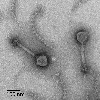Aug 29, 2015
DNase I Treatment
- James E. Thornton1
- 1Matthew Sullivan Lab, University of Arizona/Ohio State University
- VERVE Net
- Sullivan Lab

Protocol Citation: James E. Thornton 2015. DNase I Treatment. protocols.io https://dx.doi.org/10.17504/protocols.io.c3myk5
License: This is an open access protocol distributed under the terms of the Creative Commons Attribution License, which permits unrestricted use, distribution, and reproduction in any medium, provided the original author and source are credited
Protocol status: Working
Created: June 18, 2015
Last Modified: August 31, 2018
Protocol Integer ID: 845
Abstract
This protocol describes the preparation of and treatment with DNase I to degrade DNA in solutions containing iron chloride, EDTA–Mg ascorbate buffer, and cesium chloride. DNase I treatment, CsCl purification, and sucrose purification methods were compared using replicated viral metagenomics in Hurwitz et al. 2012. We use this protocol primarily to remove free host and other contaminating DNA from phage preparations prior to extracting nucleic acid from the phage particles.
Guidelines
Resuspending DNase I from powder
Determine number of units per mg powder: Roche grade II (cat.no. 10 104 159 001) contains approximately 2,000 Kunitz units per mg and comes in 100 mg size which equals 200,000 U. Resuspend in 5ml NEB recommended storage buffer, 10 mM Tris-Cl pH 7.5, 2 mM CaCl2 in 50% glycerol which equals 40,000 U/ml and store at -20°C .
Unit definition
One unit is the amount of enzyme which will completely degrade 1μg of pBR322 DNA in 10 min at 37°C in DNase I reaction buffer.
Reaction Buffer
Prepare a 10x reaction buffer containing MgCl2 and CaCl2 which are required for enzymatic activity. Final 1x buffer contains 10 mM Tris-HCl pH 7.6, 2.5 mM MgCl2, 0.5 mM CaCl2.
DNase I reaction conditions
DNase I was tested for ability to degrade DNA in solutions containing iron chloride, EDTA-Mg ascorbate buffer and cesium chloride (see BTP Exp. 72) under conditions of 37°C for 1 hr, room temperature for 2 hr and 4°C overnight. The DNA concentration (1 Kbp DNA ladder) in each solution was 200 ng/μl. The DNase I (40,000 U/ml) was diluted 1:40 in 10x reaction buffer with final concentration of 1,000U/ml (=1 U/μl) in 10x buffer. The diluted DNase I was used at a 1:10 dilution in the DNA solutions: 1 μl DNase I in 9 μl DNA. The DNA was degraded in each solution at all the reaction conditions tested.
DNase I Storage Buffer: 10 mM Tris-HCl, pH 7.5, 2 mM CaCl2 in 50% glycerol
100 μl 1 M Tris-HCl, pH 7.5 (autoclaved or filter-sterilized stock)
20 μl 1 M CaCl2 (filter-sterilized stock)
10 ml 50% Glycerol (autoclaved)
10X DNase I Reaction Buffer: 100 mM Tris-HCl, pH 7.6, 25 mM MgCl2, 5 mM CaCl2
1 ml 1 M Tris-HCl, pH 7.5 (autoclaved or filter-sterilized stock)
250 μl 1 M MgCl2 (filter-sterilized stock)
50 μl 1 M CaCl2 (filter-sterilized stock)
8.7 ml Q-water (autoclaved)
Citation: Hurwitz, B. L., Deng, L., Poulos, B. T., & Sullivan, M. B. (2012). Evaluation of methods to concentrate and purify ocean virus communities through comparative, replicated metagenomics. Environmental Microbiology. doi:10.1111/j.1462-2920.2012.02836.x
DNaseI Treatment
DNaseI Treatment
DNase I made up to 40,000 U/ml in storage buffer (-20°C freezer door) = stock solution.
DNase Treatment
DNase Treatment
Dilute stock solution 1:40 in 10x reaction buffer = 1,000 U/ml = 1 U/ul = working dilution.
Use at a 1:10 dilution: 1μl per 9 μl solution to be treated.
Incubate at room temperature for 2hr.
02:00:00
Prepare 1M EDTA disodium salt dihydrate.
Protocol

NAME
EDTA disodium salt dihydrateCREATED BY
Bonnie Poulos
Weigh out 3.72 g EDTA and place in 5 ml molecular biology grade water.
Add a few NaOH pellets to get to pH 9 and dissolve EDTA (can warm to 45°C with stirring to aid in dissolution).
Measure volume and determine molarity: 1M = 3.72g/10 ml, therefore, measured volume/10 ml = final molarity.
Prepare 1M EGTA tetrasodium salt.
Protocol

NAME
EGTA tetrasodium saltCREATED BY
Bonnie Poulos
Weigh out 4.68 g and place in 5 ml molecular biology grade water.
5 g
EGTACatalog #E8145
Stir until dissolved.
Measure volume and determine molarity: 1M = 4.68g/10 ml, therefore, measured volume/10 ml = final molarity.
Inactivate DNase by adding 100 mM EDTA/100 mM EGTA final concentration.
Note
The working DNaseI solution may be 0.02 μm filtered if being used on samples that will be used for metagenomic studies. Syringe filters are available through GE Healthcare: Anotop 25 cat. no. 6809-2102.
Although the DNaseI is active using other reactions conditions, room temperature for 2hr is recommended when working with marine viruses. Alternatively, 4C overnight may be used. Avoid using higher temperatures (eg, 37C for 1hr) as marine virual capsids may destabilize at higher temperatures.
The EDTA and EGTA stop the enzyme reaction by chelating magnesium and calcium ions that are necessary for DNaseI activity.
